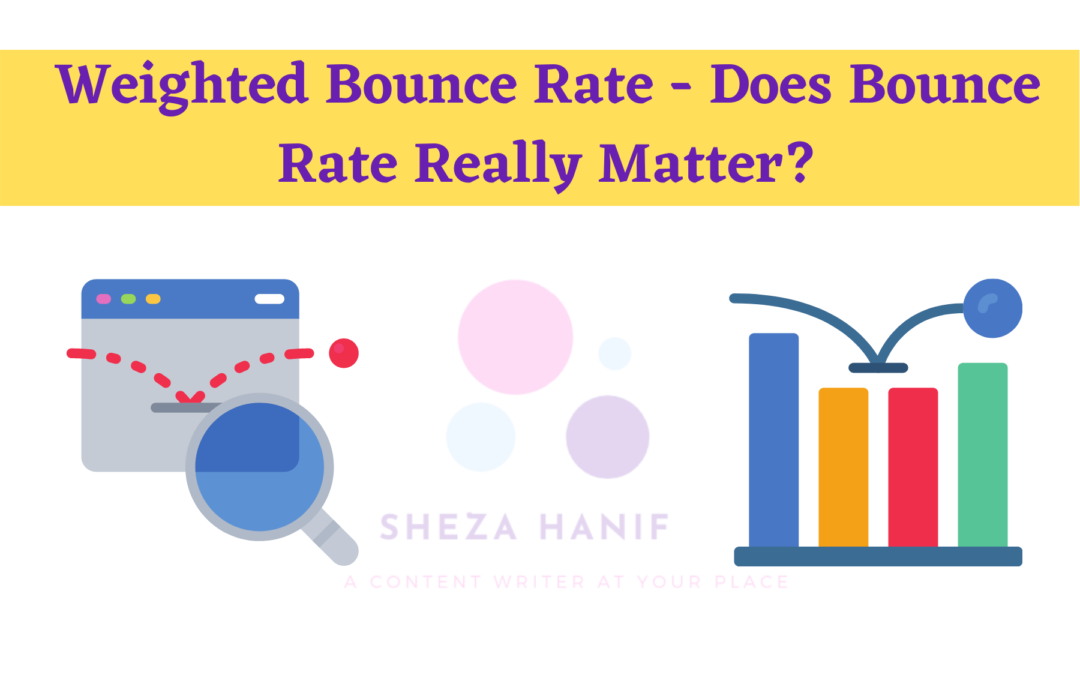Do you know what the bounce rate/ weighted bounce rate of your website is?
Or better yet, do you even know what Bounce Rate is?
You must be too busy to dig into the literature to keep up with the jargon used daily in internet marketing land. So let me keep it easy.
Your bounce rate is simply the percentage of your visitors that leave your website without visiting another page. They come in on page A; they leave on page A. You now know what the bounce rate is. Now let’s see how you lower it.
How do you lower your weighted bounce rate?
You’ve probably seen the strange word “bounce rate” in Google Analytics or some other analytics program and started googling for answers.
You now know what weighted bounce rate is, but what should you actually do with it?
If your bounce rate is on the high side, it is important to lower it. The more people click through to other pages, the more customers you get.
Most common causes of a high bounce rate
Fortunately, lowering your bounce rate isn’t high math. In fact, it’s easier than you think. Before I move on to tips to lower your bounce rate, I want to go through the most common causes with you.
If only it blinks…
If you’ve ever read an article about conversion optimization, you know that you should use eye-catching buttons and images. After all, you want to attract the attention of your visitor.
For example, you want to send them to your contact page or opt-in list to have them subscribe to your newsletter—all very good. But please stop loading flash, moving pictures, or music.
Nobody likes flashing pictures, so don’t use them. Anything you use on your website that can only shred attention will increase your bounce rate!
No idea where you are
Your visitors are impatient creatures. They hunt for information and products and want to go ‘home’ as soon as possible.
This means that you have to give your visitor exactly what they are looking for. Is your visitor lost? Then easily show him the way.
This is already possible with a clear menu on the right or left side of your text. But also with an extra menu in your header (the bar at the top of your website), navigation in your footer (bar at the bottom of your website), and a breadcrumb (navigation on the page itself).
Why the loading time of your website is so important
Both Google and your visitors hate a too-high loading time. After all, you are on the internet to find the requested information as quickly as possible. So make sure your website loads fast enough.
It’s not Yellow Pages.
More and more people are discovering Google AdSense. This service allows affiliates to use their website to display advertisements. As soon as one of your visitors clicks on an ad, you get paid for it.
Extra pocket money is nice, but don’t turn it into a Yellow Pages.
3 easy tips to lower your bounce rate
Okay, you are shocked by your bounce rate and not guilty of most of the above causes of a high bounce rate?
What do you have to do then?
Do not panic. These three tips will help you easily lower your weighted bounce rate.
#1 An honest advertisement with your meta description
In Google, you can advertise for free with your meta description. You can use this small piece of text that appears in Google search results to encourage visitors to click on your website.
Everyone should visit your website logically. Try to stay relevant. Use this opportunity to make your visitors enthusiastic about your article or product, but don’t promise them information that you don’t deliver later.
#2 Internal linking
Internal linking, linking from page A to page B on your website, ensures that your visitors are stimulated to dive deeper into the matter. In addition, using internal links is not a bad idea anyway because it is good for your on-site optimization.
Referring to other relevant pages also helps you keep your visitor on your website longer. After all, they click through from page A to page B, which immediately lowers your Bounce Rate.
#3 Always opt for ease of use
In the past, creating a website was mainly about your logo, corporate identity, and the latest gadgets. Today we have become accustomed to that luxury, and it is the new standard. Still, it seems that websites need to become simpler.
Although your website should, of course, also look nice, you start with ease of use. Where do you put what, and how do you ensure that your visitor always finds their way?
If you provide a user-friendly website and use strong landing pages, your visitors will stay on your website longer, they will click through more, and you are guaranteed to lower your bounce rate.
Bounce rate and the effect on your position in Google
When SEO copywriters talk about writing SEO texts, they are always talking about keywords and on-site optimization. While that is also important, in my view, the Dwell Time is the most important.
With the keywords, on-site and off-site (link building) optimization, you come to the top, but the dwell time determines whether you stay there. If you look at your bounce rate, it can affect your dwell time.

